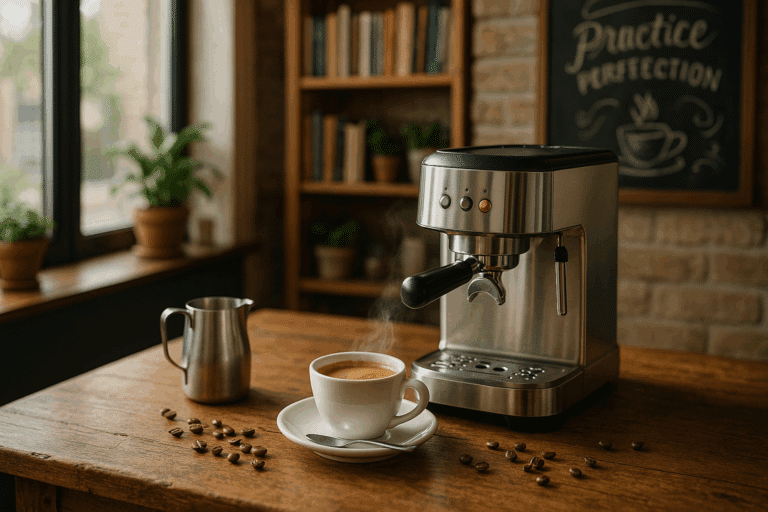☕ Pull up a chair, brew yourself a hot cup of your favorite coffee, and let’s delve into an art that marries precision with passion. In this comprehensive guide, we will walk you through the art of mastering the perfect brew. Not only will you learn about the importance of timing in brewing, but you will also be challenged to take on the Stopwatch Challenge – a test of your ability to perfectly time your brewing process.
The craft of brewing isn’t simply about mixing water with coffee grounds. It’s a science, a delicate dance of heat, time, and careful measurement, resulting in an experience that transcends the simple act of drinking coffee. Your brewing timing skills can dramatically impact the quality of your brew. A few seconds too long, and your coffee could end up bitter. A few seconds too short, and it might taste weak and under-extracted.
The Stopwatch Challenge isn’t just about perfecting your timing skills. It’s about understanding the intricacies of the brewing process, the importance of each step, and how timing plays a critical role in each of them. This guide is more than just a how-to; it’s a journey into the heart of the coffee brewing process, where we’ll reveal the science behind the magic. ☕️
What to Expect
Through the following sections of this guide, you’ll encounter a blend of theory and practice. Here is what you should expect:
First, we’ll start with the Basics of Brewing. This section will lay the foundation for understanding the brewing process. It will explore the factors that influence the taste of your brew and why timing is paramount in this process.
Next, we’ll move onto the Stopwatch Challenge. This is where we’ll put theory into practice. We’ll take you step-by-step through the brewing process, demonstrating how to time each step accurately for the perfect brew.
After that, we’ll delve into the Science of Brewing. If you’ve ever wondered why over-extraction makes your coffee bitter or why under-extraction leads to a weak brew, this section is for you. We’ll peel back the layers of the brewing process to reveal the chemical reactions happening in your cup.
Finally, we’ll wrap up with Tips and Tricks to Perfect Your Timing Skills. Once you’ve grasped the basics and understand the science, it’s time to take your brewing game to the next level. This section is packed with expert advice to help you fine-tune your timing skills and brew a cup of coffee that rivals those of professional baristas.
So, whether you’re a seasoned coffee connoisseur or a beginner just dipping your toes into the world of brewing, this guide is for you. Get ready to embrace the Stopwatch Challenge and revolutionize your brewing process. By the end of this guide, not only will you have honed your timing skills, but you’ll also have a deeper appreciation for the art and science that goes into every cup of coffee. Let’s dive in! ☕️
The Science of Brewing: Understanding the Basics
First and foremost, it is crucial to establish a solid grounding in the fundamentals of brewing before diving into the complexities of timing and technique. Whether your beverage of choice is coffee, tea, or something else entirely, the principles remain consistent.
Brewing is a delicate science, requiring careful balance between temperature, time, and the quantity of your chosen brew. Too much or too little of any one element can drastically alter the flavor and quality of your final product. To master the perfect brew, it is essential to understand the role each component plays in the process.
Temperature, for instance, has a direct impact on the extraction process. Higher temperatures result in faster extraction, which can lead to a more robust flavor. However, if the temperature is too high, it may cause over-extraction and result in a bitter taste. On the flip side, lower temperatures can lead to under-extraction, producing a weak or watered-down flavor.
The Stopwatch Challenge: Mastering Timing in Brewing
Having established the basics, let’s now turn our attention to the vital role timing plays in the brewing process. The Stopwatch Challenge is a fun and effective way to fine-tune your timing skills. The goal is simple: accurately gauge the brewing time without using a timer.
While this might sound trivial, it’s a skill that requires practice and precision. Over time, mastering the Stopwatch Challenge can significantly improve your brewing results. You’ll develop a keen sense of timing, allowing you to adjust and adapt your brewing process on the fly for optimal flavor.
For a visual guide on how to undertake the Stopwatch Challenge, watch the video “Master the Perfect Brew: Stopwatch Challenge” by the YouTube channel ‘Brewing Perfection’. You’ll find step-by-step instructions and useful tips to help you refine your brewing timing skills.
Comparing Different Brewing Techniques
Now that we’ve covered the importance of time and temperature in brewing, let’s look at how these elements come into play in different brewing methods. We’ll compare the French Press, Pour-Over, and Espresso methods, highlighting the distinct timings and temperatures required for each.
| Brewing Method | Typical Brew Time | Recommended Temperature |
|---|---|---|
| French Press | 4-5 minutes | 195-205°F (90-96°C) |
| Pour-Over | 2-3 minutes | 195-205°F (90-96°C) |
| Espresso | 20-30 seconds | 190-200°F (88-93°C) |
As the table illustrates, each brewing method requires its unique set of timings and temperatures to achieve optimal results. By understanding these variations, you can apply your newly acquired Stopwatch Challenge skills to master the art of brewing, regardless of your chosen method.
Advanced Tips for the Perfect Brew
Mastering the basics of brewing and timing is a significant step towards achieving the perfect brew. However, to truly take your brewing skills to the next level, you’ll need to delve deeper into the world of brewing science.
One such advanced concept is the grind size of your brew. Whether you’re working with coffee beans or loose-leaf tea, the size of your grind can greatly influence the extraction process. Finer grinds offer a larger surface area for extraction, resulting in a stronger flavor. Conversely, coarser grinds provide less surface area, leading to a milder taste.
Additionally, the quality of your water can significantly impact the taste of your brew. Minerals in water can interact with your brew, altering its flavor profile. As a general rule, using filtered or bottled water can help ensure a clean, unadulterated flavor in your final brew.
For more advanced tips and tricks on perfecting your brew, check out the YouTube video “Advanced Brewing Techniques” by ‘Brewing Masters’. This comprehensive guide delves into the intricacies of brewing science, providing invaluable insights for brewing enthusiasts.

Conclusion
To wrap up our comprehensive dive into the subject, let’s take a step back and revisit some of the key points we’ve covered in this piece.
To begin with, we explored the fundamental principles underlying Software Engineering, a discipline whose importance in our increasingly digital world cannot be overstated. As we detailed, the field involves both the development and maintenance of software systems, with a focus on functionality, reliability, and efficiency. The rigorous process involved includes everything from initial problem analysis, through system design and coding, to testing, debugging, and maintenance.
We also took a close look at some of the most critical aspects of technical writing in the IT and Engineering sectors. Technical writing, as we’ve seen, requires an exceptional skill set, blending deep domain knowledge with the ability to communicate complex concepts clearly and effectively. This ability to make the complex understandable is, in many ways, the heart of technical writing. It’s a discipline that’s vital for everything from software development to data analysis, from project management to user documentation.
Throughout this exploration, we’ve seen how these two fields – software engineering and technical writing – intersect. The best software engineers are often excellent technical writers, able to not only create efficient code, but also to explain their processes and decisions clearly and effectively. Similarly, the best technical writers often have a strong understanding of software engineering principles, allowing them to communicate complex concepts accurately and in a way that resonates with their readers.
The importance of these skills in our increasingly digital, data-driven world cannot be overstated. As more and more of our lives move online, the demand for professionals with expertise in software engineering and technical writing is only set to grow. Whether you’re an experienced professional looking to sharpen your skills, or a newcomer looking to break into these fields, there’s never been a better time to learn.
If you’ve found this article helpful, we encourage you to share it with your network and contribute to the conversation. If you have any thoughts, comments, or questions, please don’t hesitate to leave them in the comments section below. We love hearing from our readers and value your insights.
To further expand your knowledge, consider exploring some of the resources we’ve linked throughout this article, each of which provides in-depth information on various aspects of software engineering and technical writing. We’ve strived to provide only active, reputable links, as we understand the value of reliable and up-to-date information.
In conclusion, we hope you’ve found this deep dive into the intersection of software engineering and technical writing both informative and inspiring. Whether you’re a seasoned professional or an aspiring newcomer, we believe there’s always more to learn and explore. So, keep striving, keep learning, and keep pushing the boundaries of what’s possible. Because in our digital age, the only constant is change.
So, stay curious, stay connected and keep exploring the fascinating world of software engineering and technical writing. As always, thank you for reading, and until next time, happy coding! 😊👨💻👩💻🚀



